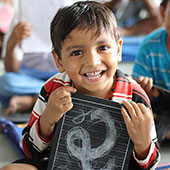Home / Courses / Designing for Children - Play and Learn / Play Theories and Design / Caillois’s Attitudes in Play Experience
Design Course
Designing for Children - Play and Learn
Play and Learn
by
Roger Caillois studied play and culture in his famous book Man, Play and Games, describing play by six characteristics: free-not obligatory, limited in time and space, uncertain, unproductive, governed by intrinsic rules and allows makes-believe. Caillois also identified four broad attitudes in play experiences, which lead to four play forms, on a continuum from completely unstructured, free play to structured, rule-based play:
• Agon or Competition: Based on the idea of winning by mastering a single quality/skill against opponents, within defined limits and without outside assistance such that there is an equal chance of winning e.g. chess.
• Alea or Chance: Based on the idea of winning by favor/luck, rather than skill and experiencing pleasure in the lack of control and anticipation. Agon and Alea both involve creating conditions of equality. E.g. slot machine.
• Mimicry or Role Playing: Based on pretending to be another to convince others (audience) such that imaginative reality is maintained. Unlike Agon and Alea, mimicry does not have explicit rules or conditions but relies on improvisations. E.g. playing doctor-patient.
• Ilinx or Vertigo: Based on the pleasure from altering perception and shocking self through bodily movement. It may also involve pleasure in destruction/disruption of moral order. E.g. roller-coaster ride.
It is common to use these categories in combination. Some of these categories are traditionally seen as more compatible e.g. Agon and Alea (both being rule based) could be seen together in poker and similar card games. Similarly, mimicry and ilinx being unstructured are compatible together. This makes the classification a useful framework for design applications by exploring one or more of these categories to create playfulness.


